Mesoscale Temporal Wind Variability Biases Global Air–Sea Gas Transfer Velocity of CO2 and Other Slightly Soluble Gases
Abstract
1. Introduction
2. Data and Methods
2.1. Data and Data Processing
2.2. Review of Prior Correction Methods for the Time-Average Bias
2.3. Proposed Correction Based on Taylor Series Expansions
3. Results
3.1. Bias in k Induced by Averaging of Wind Data
3.2. Assessment of the “Bias Correction Model”
3.3. Comparison of Correction Methods
3.4. Study Limitation
4. Conclusions
Supplementary Materials
Author Contributions
Funding
Acknowledgments
Conflicts of Interest
References
- Katul, G.; Mammarella, I.; Grönholm, T.; Vesala, T. A structure function model recovers the many formulations for air-water gas transfer velocity. Water Resour. Res. 2018, 54, 5905–5920. [Google Scholar] [CrossRef]
- Esters, L.; Landwehr, S.; Sutherland, G.; Bell, T.G.; Christensen, K.H.; Saltzman, E.S.; Miller, S.D.; Ward, B. Parameterizing air-sea gas transfer velocity with dissipation. J. Geophys. Res. Oceans 2017, 122, 3041–3056. [Google Scholar] [CrossRef]
- Zappa, C.J.; McGillis, W.R.; Raymond, P.A.; Edson, J.B.; Hintsa, E.J.; Zemmelink, H.J.; Dacey, J.W.H.; Ho, D.T. Environmental turbulent mixing controls on air-water gas exchange in marine and aquatic systems. Geophys. Res. Lett. 2007, 34. [Google Scholar] [CrossRef]
- Soloviev, A.V. Coupled renewal model of ocean viscous sublayer, thermal skin effect and interfacial gas transfer velocity. J. Mar. Syst. 2007, 66, 19–27. [Google Scholar] [CrossRef]
- Vieira, V.M.N.C.; Mateus, M.; Canelas, R.; Leitão, F. The FuGas 2.5 Updated for the Effects of Surface Turbulence on the Transfer Velocity of Gases at the Atmosphere–Ocean Interface. J. Mar. Sci. Eng. 2020, 8, 435. [Google Scholar] [CrossRef]
- Liang, J.; Deutsch, C.; McWilliams, J.C.; Baschek, B.; Sullivan, P.P.; Chiba, D. Parameterizing bubble-mediated air-sea gas exchange and its effect on ocean ventilation. Glob. Biogeochem. Cycles 2013, 27, 894–905. [Google Scholar] [CrossRef]
- Woolf, D.K.; Leifer, I.S.; Nightingale, P.D.; Rhee, T.S.; Bowyer, P.; Caulliez, G.; de Leeuw, G.; Larsen, S.E.; Liddicoat, M.; Baker, J.; et al. Modelling of bubble-mediated gas transfer: Fundamental principles and a laboratory test. J. Mar. Syst. 2007, 66, 71–91. [Google Scholar] [CrossRef]
- Deike, L.; Melville, W.K. Gas transfer by breaking waves. Geophys. Res. Lett. 2018, 45, 410–482. [Google Scholar] [CrossRef]
- Zavarsky, A.; Goddijn Murphy, L.; Steinhoff, T.; Marandino, C.A. Bubble-Mediated Gas Transfer and Gas Transfer Suppression of DMS and CO2. J. Geophys. Res. Atmos. 2018, 123, 6624–6647. [Google Scholar] [CrossRef]
- Goddijn Murphy, L.; Woolf, D.K.; Callaghan, A.H.; Nightingale, P.D.; Shutler, J.D. A reconciliation of empirical and mechanistic models of the air-sea gas transfer velocity. J. Geophys. Res. Oceans 2016, 121, 818–835. [Google Scholar] [CrossRef]
- Van der Hoven, I. Power spectrum of horizontal wind speed in the frequency range from 0.0007 to 900 cycles per hour. J. Meteorol. 1957, 14, 160–164. [Google Scholar] [CrossRef]
- Stull, R.B. An Introduction to Boundary Layer Meteorology; Springer: Dordrecht, The Netherlands, 1988. [Google Scholar]
- Takahashi, T.; Sutherland, S.C.; Wanninkhof, R.; Sweeney, C.; Feely, R.A.; Chipman, D.W.; Hales, B.; Friederich, G.; Chavez, F.; Sabine, C.; et al. Climatological mean and decadal change in surface ocean pCO2, and net sea–air CO2 flux over the global oceans. Deep Sea Res. Part II Top. Stud. Oceanogr. 2009, 56, 554–577. [Google Scholar] [CrossRef]
- Gruber, N.; Gloor, M.; Mikaloff Fletcher, S.E.; Doney, S.C.; Dutkiewicz, S.; Follows, M.J.; Gerber, M.; Jacobson, A.R.; Joos, F.; Lindsay, K.; et al. Oceanic sources, sinks, and transport of atmospheric CO2. Glob. Biogeochem. Cycles 2009, 23, B1005. [Google Scholar] [CrossRef]
- Wanninkhof, R.; Park, G.H.; Takahashi, T.; Sweeney, C.; Feely, R.; Nojiri, Y.; Gruber, N.; Doney, S.C.; McKinley, G.A.; Lenton, A.; et al. Global ocean carbon uptake: Magnitude, variability and trends. Biogeosciences 2013, 10, 1983–2000. [Google Scholar] [CrossRef]
- Landschützer, P.; Gruber, N.; Bakker, D.C.E.; Schuster, U. Recent variability of the global ocean carbon sink. Glob. Biogeochem. Cycles 2014, 28, 927–949. [Google Scholar] [CrossRef]
- Rödenbeck, C.; Bakker, D.C.E.; Gruber, N.; Iida, Y.; Jacobson, A.R.; Jones, S.; Landschützer, P.; Metzl, N.; Nakaoka, S.; Olsen, A.; et al. Data-based estimates of the ocean carbon sink variability—First results of the Surface Ocean pCO2 Mapping intercomparison (SOCOM). Biogeosciences 2015, 12, 7251–7278. [Google Scholar] [CrossRef]
- Friedlingstein, P.; Jones, M.W.; O’sullivan, M.; Andrew, R.M.; Hauck, J.; Peters, G.P.; Peters, W.; Pongratz, J.; Sitch, S.; Quéré, C.L.; et al. Global Carbon Budget 2019. Earth Syst. Sci. Data 2019, 11, 1783–1838. [Google Scholar] [CrossRef]
- Ward, B.; Wanninkhof, R.; McGillis, W.R.; Jessup, A.T.; DeGrandpre, M.D.; Hare, J.E.; Edson, J.B. Biases in the air-sea flux of CO2 resulting from ocean surface temperature gradients. J. Geophys. Res. Oceans 2004, 109, C8S. [Google Scholar] [CrossRef]
- Takahashi, T.; Sutherland, S.C.; Chipman, D.W.; Goddard, J.G.; Ho, C.; Newberger, T.; Sweeney, C.; Munro, D.R. Climatological distributions of pH, pCO2, total CO2, alkalinity, and CaCO3 saturation in the global surface ocean, and temporal changes at selected locations. Mar. Chem. 2014, 164, 95–125. [Google Scholar] [CrossRef]
- Bakker, D.C.E.; Pfeil, B.; Smith, K.; Hankin, S.; Olsen, A.; Alin, S.R.; Cosca, C.; Harasawa, S.; Kozyr, A.; Nojiri, Y.; et al. An update to the Surface Ocean CO2; Atlas (SOCAT version 2). Earth Syst. Sci. Data 2014, 6, 69–90. [Google Scholar] [CrossRef]
- Woolf, D.K.; Land, P.E.; Shutler, J.D.; Goddijn-Murphy, L.M.; Donlon, C.J. On the calculation of air-sea fluxes of CO2 in the presence of temperature and salinity gradients. J. Geophys. Res. Oceans 2016, 121, 1229–1248. [Google Scholar] [CrossRef]
- Roobaert, A.; Laruelle, G.G.; Landschützer, P.; Regnier, P. Uncertainty in the global oceanic CO2 uptake induced by wind forcing: Quantification and spatial analysis. Biogeosciences 2018, 15, 1701–1720. [Google Scholar] [CrossRef]
- Woolf, D.K.; Shutler, J.D.; Goddijn Murphy, L.; Watson, A.J.; Chapron, B.; Nightingale, P.D.; Donlon, C.J.; Piskozub, J.; Yelland, M.J.; Ashton, I.; et al. Key uncertainties in the recent air—Sea flux of CO2. Glob. Biogeochem. Cycles 2019, 33, 1548–1563. [Google Scholar] [CrossRef]
- Chiodi, A.M.; Dunne, J.P.; Harrison, D.E. Estimating Air-Sea Carbon Flux Uncertainty over the Tropical Pacific: Importance of Winds and Wind Analysis Uncertainty. Glob. Biogeochem. Cycles 2019, 33, 370–390. [Google Scholar] [CrossRef]
- Wanninkhof, R. The effect of using time-averaged winds on regional air-sea CO2 fluxes. Geophys. Monogr. Am. Geophys. Union 2002, 127, 351–356. [Google Scholar]
- Fangohr, S.; Woolf, D.K.; Jeffery, C.D.; Robinson, I.S. Calculating long-term global air-sea flux of carbon dioxide using scatterometer, passive microwave, and model reanalysis wind data. J. Geophys. Res. 2008, 113, C9032. [Google Scholar] [CrossRef]
- Jiang, L.; Cai, W.; Wanninkhof, R.; Wang, Y.; Lüger, H. Air-sea CO2 fluxes on the U.S. South Atlantic Bight: Spatial and seasonal variability. J. Geophys. Res. 2008, 113, C7019. [Google Scholar] [CrossRef]
- Wanninkhof, R. Relationship between wind speed and gas exchange. J. Geophys. Res. Atmos. 1992, 97, 7373–7382. [Google Scholar] [CrossRef]
- Wanninkhof, R.; McGillis, W.R. A cubic relationship between air—Sea CO2 exchange and wind speed. Geophys. Res. Lett. 1999, 26, 1889–1892. [Google Scholar] [CrossRef]
- Feely, R.A.; Wanninkhof, R.; McGillis, W.; Carr, M.E.; Cosca, C.E. Effects of wind speed and gas exchange parameterizations on the air-sea CO2 fluxes in the equatorial Pacific Ocean. J. Geophys. Res. Oceans 2004, 109, C3S–C8S. [Google Scholar] [CrossRef]
- Sarmiento, J.L.G.N. Ocean Biogeochemical Dynamics; Princeton University Press: Princeton, NJ, USA, 2006. [Google Scholar]
- Wanninkhof, R. Relationship between wind speed and gas exchange over the ocean revisited. Limnol. Oceanogr. Methods 2014, 12, 351–362. [Google Scholar] [CrossRef]
- Nightingale, P.M.G.L. In situ evaluation of air-sea gas exchange parameterizations using novel conservative and volatile tracers. Glob. Biogeochem. Cycles 2000, 14, 373–387. [Google Scholar] [CrossRef]
- McGillis, W.R.; Edson, J.B.; Ware, J.D.; Dacey, J.W.H.; Hare, J.E.; Fairall, C.W.; Wanninkhof, R. Carbon dioxide flux techniques performed during GasEx-98. Mar. Chem. 2001, 75, 267–280. [Google Scholar] [CrossRef]
- McGillis, W.R.; Edson, J.B.; Zappa, C.J.; Ware, J.D.; McKenna, S.P.; Terray, E.A.; Hare, J.E.; Fairall, C.W.; Drennan, W.; Donelan, M.; et al. Air-sea CO2 exchange in the equatorial Pacific. J. Geophys. Res. Oceans 2004, 109, C2S–C8S. [Google Scholar] [CrossRef]
- Weiss, A.; Kuss, J.; Peters, G.; Schneider, B. Evaluating transfer velocity-wind speed relationship using a long-term series of direct eddy correlation CO2 flux measurements. J. Mar. Syst. 2007, 66, 130–139. [Google Scholar] [CrossRef]
- Wanninkhof, R.; Asher, W.E.; Ho, D.T.; Sweeney, C.; McGillis, W.R. Advances in quantifying air-sea gas exchange and environmental forcing. Annu. Rev. Mar. Sci. 2009, 1, 213–244. [Google Scholar] [CrossRef] [PubMed]
- Prytherch, J.; Yelland, M.J.; Pascal, R.W.; Moat, B.I.; Skjelvan, I.; Srokosz, M.A. Open ocean gas transfer velocity derived from long-term direct measurements of the CO2 flux. Geophys. Res. Lett. 2010, 37, L23607. [Google Scholar] [CrossRef]
- Ho, D.T.; Law, C.S.; Smith, M.J.; Schlosser, P.; Harvey, M.; Hill, P. Measurements of air-sea gas exchange at high wind speeds in the Southern Ocean: Implications for global parameterizations. Geophys. Res. Lett. 2006, 33, L16611. [Google Scholar] [CrossRef]
- Sweeney, C.; Gloor, E.; Jacobson, A.R.; Key, R.M.; McKinley, G.; Sarmiento, J.L.; Wanninkhof, R. Constraining global air-sea gas exchange for CO2 with recent bomb14C measurements. Glob. Biogeochem. Cycles 2007, 21, B2015. [Google Scholar] [CrossRef]
- Atlas, R.; Hoffman, R.N.; Ardizzone, J.; Leidner, S.M.; Jusem, J.C.; Smith, D.K.; Gombos, D. A Cross-calibrated, Multiplatform Ocean Surface Wind Velocity Product for Meteorological and Oceanographic Applications. Bull. Am. Meteorol. Soc. 2011, 92, 157–174. [Google Scholar] [CrossRef]
- Wanninkhof, R.; Triñanes, J. The impact of changing wind speeds on gas transfer and its effect on global air-sea CO2 fluxes. Glob. Biogeochem. Cycles 2017, 31, 961–974. [Google Scholar] [CrossRef]
- Kent, E.C.; Fangohr, S.; Berry, D.I. A comparative assessment of monthly mean wind speed products over the global ocean. Int. J. Climatol. 2013, 33, 2520–2541. [Google Scholar] [CrossRef]
- Li, Q.; Guo, X.; Zhai, W.; Xu, Y.; Dai, M. Partial pressure of CO2 and air-sea CO2 fluxes in the South China Sea: Synthesis of an 18-year dataset. Prog. Oceanogr. 2020, 182, 102272. [Google Scholar] [CrossRef]
- Service, C.C.C. ERA5: Fifth Generation of ECMWF Atmospheric Reanalyses of the Global Climate. Available online: https://confluence.ecmwf.int/display/CKB/ERA5%3A+data+documentation (accessed on 7 February 2021).
- Etcheto, J.B.A.J. Estimating the chemical enhancement effect on the air-sea CO2 exchange using the ERS1 scatterometer wind speeds. In Air-Water Gas Transfer; AEON Verlag & Studio: Hanau, Germany, 1995; pp. 827–841. [Google Scholar]
- Wanninkhof, R.; Sullivan, K.F.; Top, Z. Air-sea gas transfer in the Southern Ocean. J. Geophys. Res. Oceans 2004, 109, C8S–C19S. [Google Scholar] [CrossRef]
- Lüger, H.; Wanninkhof, R.; Wallace, D.W.R.; Körtzinger, A. CO2 fluxes in the subtropical and subarctic North Atlantic based on measurements from a volunteer observing ship. J. Geophys. Res. 2006, 111, L6024. [Google Scholar] [CrossRef]
- Zhang, X.; Cai, W. On some biases of estimating the global distribution of air-sea CO2 flux by bulk parameterizations. Geophys. Res. Lett. 2007, 34, L1608. [Google Scholar] [CrossRef]
- Xue, L.; Xue, M.; Zhang, L.; Sun, T.; Guo, Z.; Wang, J. Surface partial pressure of CO2 and air-sea exchange in the northern Yellow Sea. J. Mar. Syst. 2012, 105–108, 194–206. [Google Scholar] [CrossRef]
- Astor, Y.M.; Lorenzoni, L.; Guzman, L.; Fuentes, G.; Muller-Karger, F.; Varela, R.; Scranton, M.; Taylor, G.T.; Thunell, R. Distribution and variability of the dissolved inorganic carbon system in the Cariaco Basin, Venezuela. Mar. Chem. 2017, 195, 15–26. [Google Scholar] [CrossRef]
- Olsen, A.W.R.T. The effect of wind speed products and wind speed-gas exchange relationships on interannual variability of the air-sea CO2 gas transfer velocity. Tellus B 2005, 57, 95–106. [Google Scholar] [CrossRef][Green Version]
- Sampe, T.A.X.S. Mapping high sea winds from space: A global climatology. Bull. Am. Meteorol. Soc. 2007, 12, 1965–1978. [Google Scholar] [CrossRef]
- Liang, J.H.; D’Asaro, E.A.; McNeil, C.L.; Fan, Y.; Harcourt, R.R.; Emerson, S.R.; Yang, B.; Sullivan, P.P. Suppression of CO2 Outgassing by Gas Bubbles Under a Hurricane. Geophys. Res. Lett. 2020, 47, e2020G–e90249G. [Google Scholar] [CrossRef]
- Atamanchuk, D.; Koelling, J.; Send, U.; Wallace, D.W.R. Rapid transfer of oxygen to the deep ocean mediated by bubbles. Nat. Geosci. 2020, 13, 232–237. [Google Scholar] [CrossRef]
- Leighton, T.G.; Coles, D.G.H.; Srokosz, M.; White, P.R.; Woolf, D.K. Asymmetric transfer of CO2 across a broken sea surface. Sci. Rep. 2018, 8, 1–9. [Google Scholar] [CrossRef]
- Charney, J.G. Geostrophic turbulence. J. Atmos. Sci. 1971, 28, 1087–1095. [Google Scholar] [CrossRef]
- Nastrom, G.D. A climatology of atmospheric wavenumber spectra of wind and temperature observed by commercial aircraft. J. Atmos. Sci. 1985, 42, 950–960. [Google Scholar] [CrossRef]
- Large, W.B. Surface fluxes for practitioners of global ocean data assimilation. In Ocean Weather Forecasting; Springer: Dordrecht, The Netherlands, 2006; pp. 227–270. [Google Scholar]
- Young, I.R.; Zieger, S.; Babanin, A.V. Global trends in wind speed and wave height. Science 2011, 332, 451–455. [Google Scholar] [CrossRef]
- Young, I.R.; Ribal, A. Multiplatform evaluation of global trends in wind speed and wave height. Science 2019, 364, 548–552. [Google Scholar] [CrossRef]
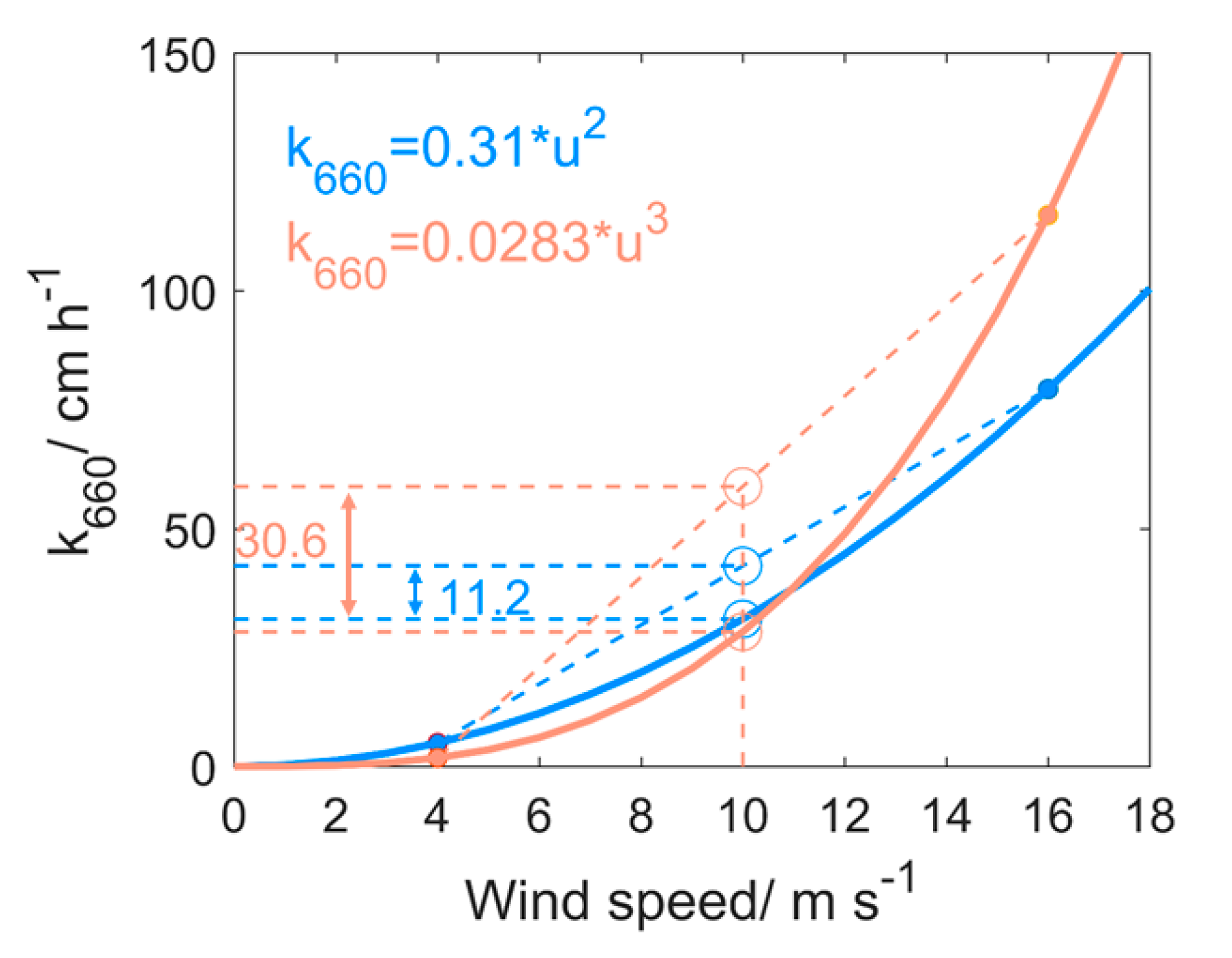

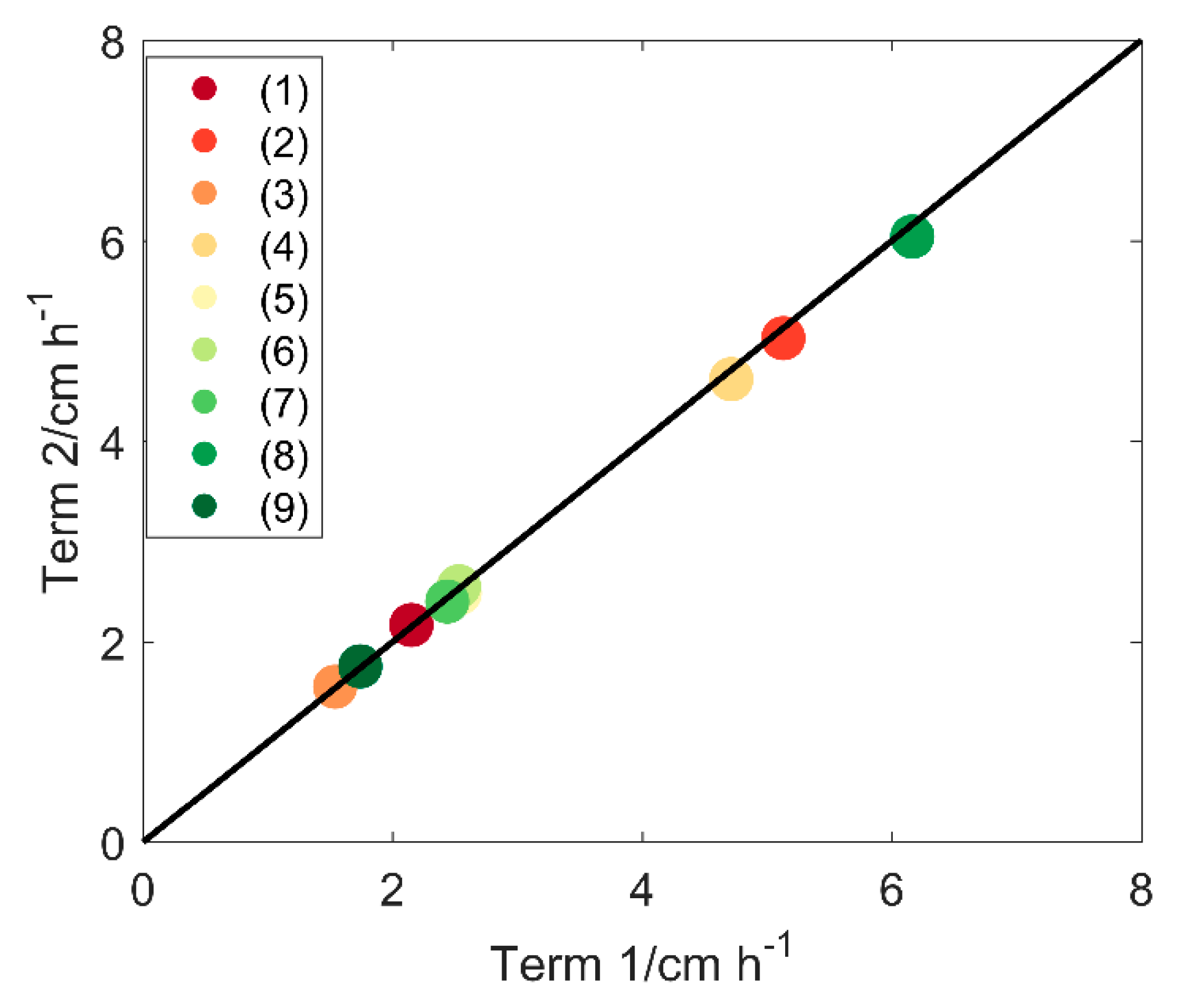
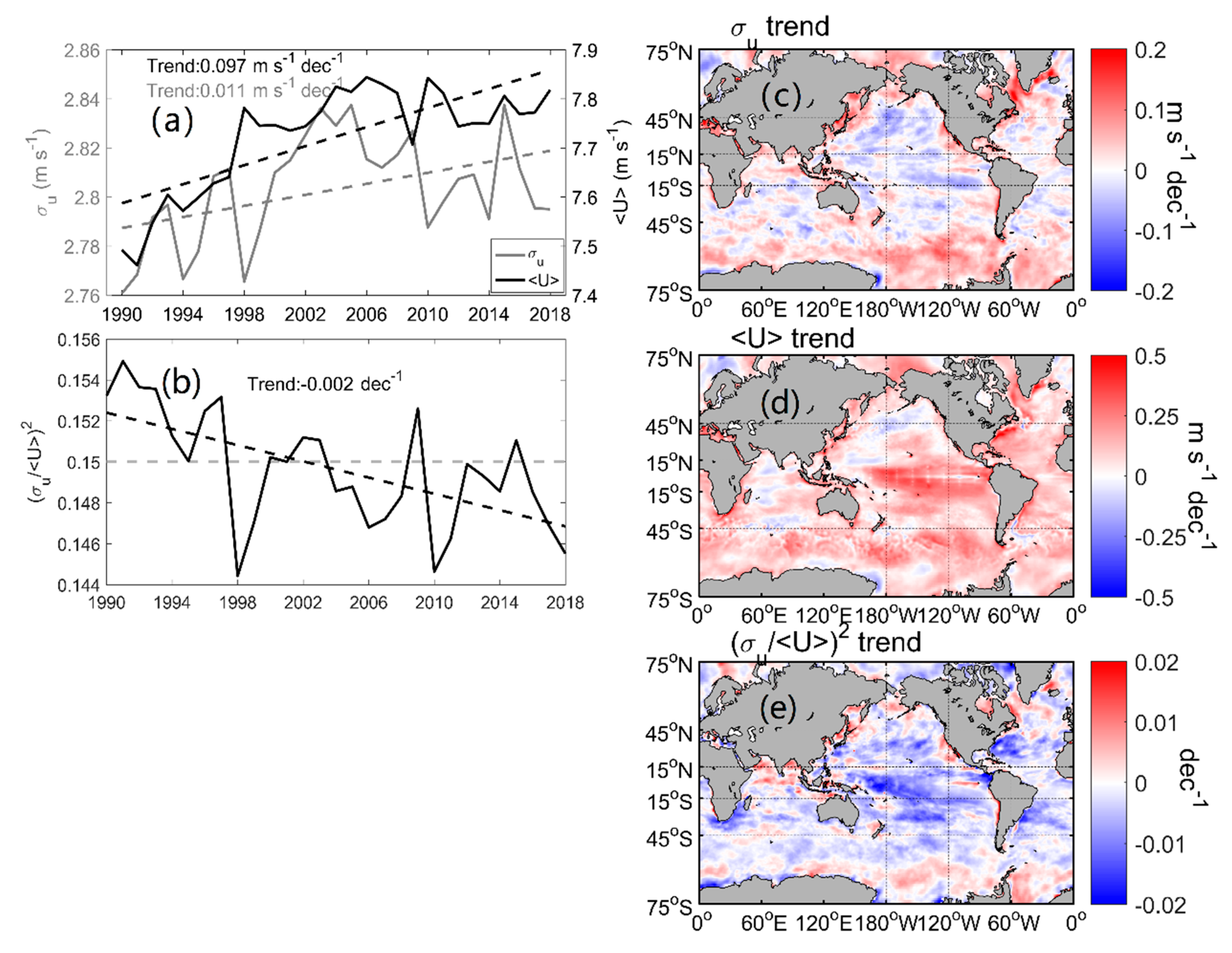

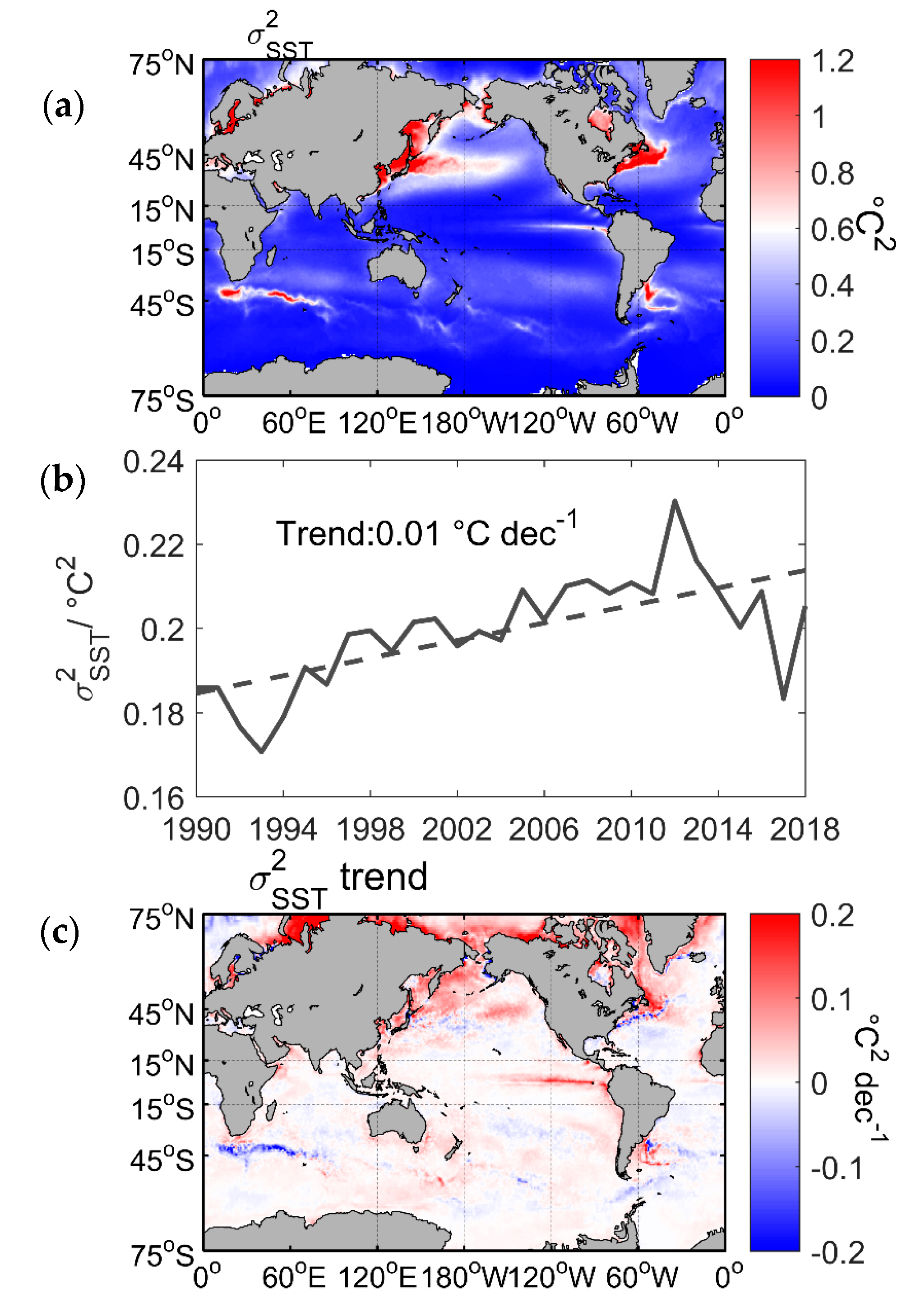
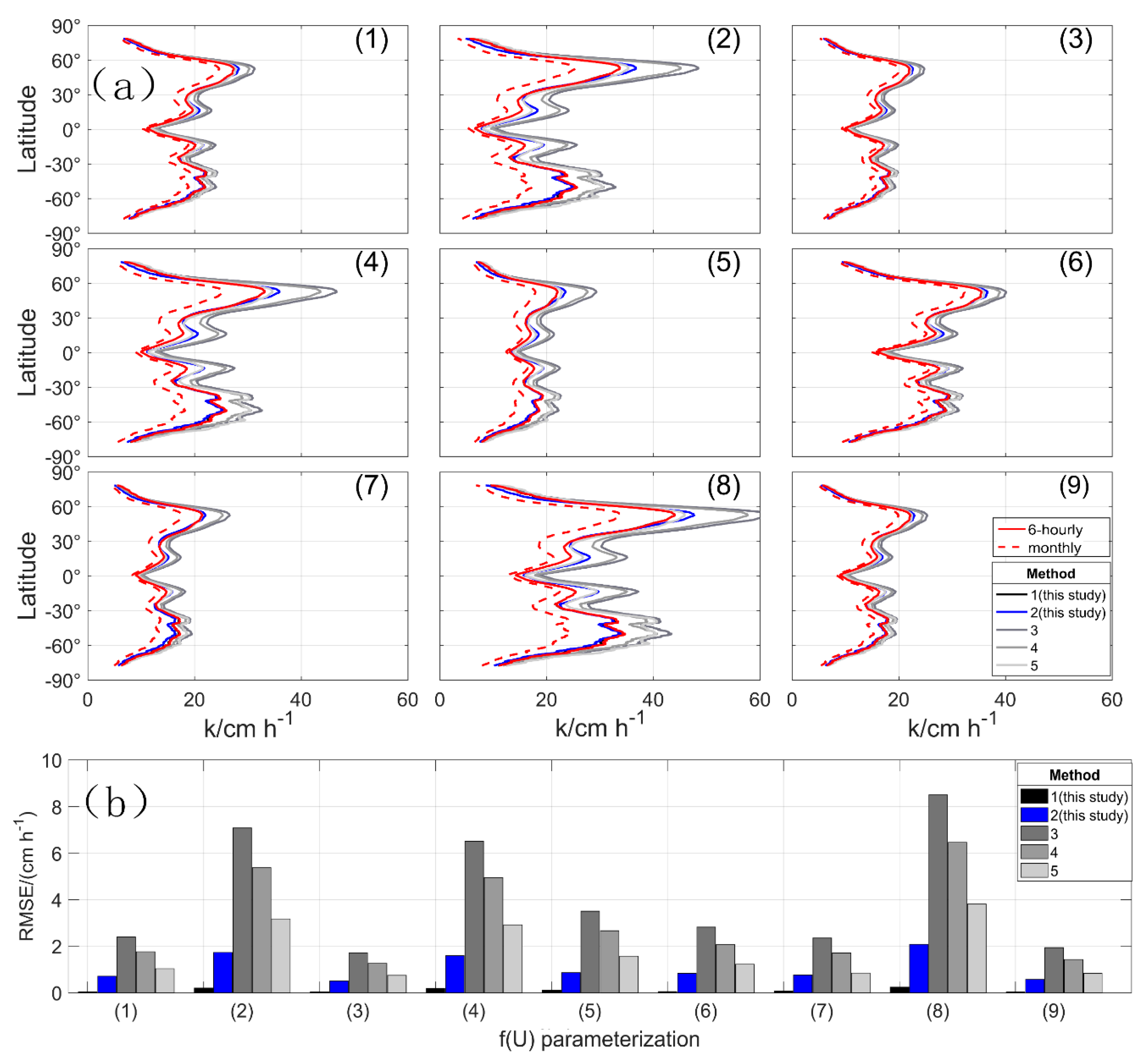
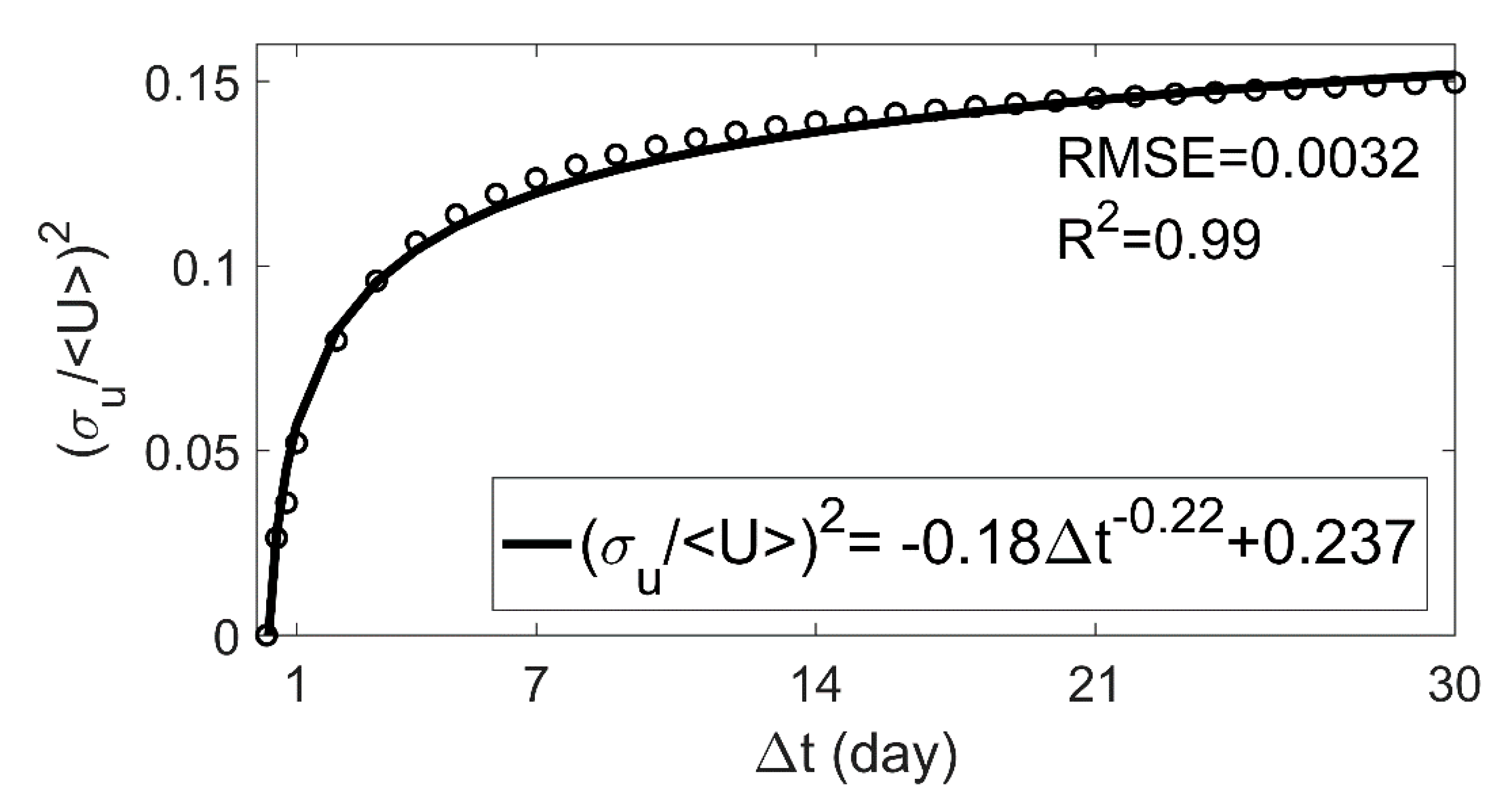
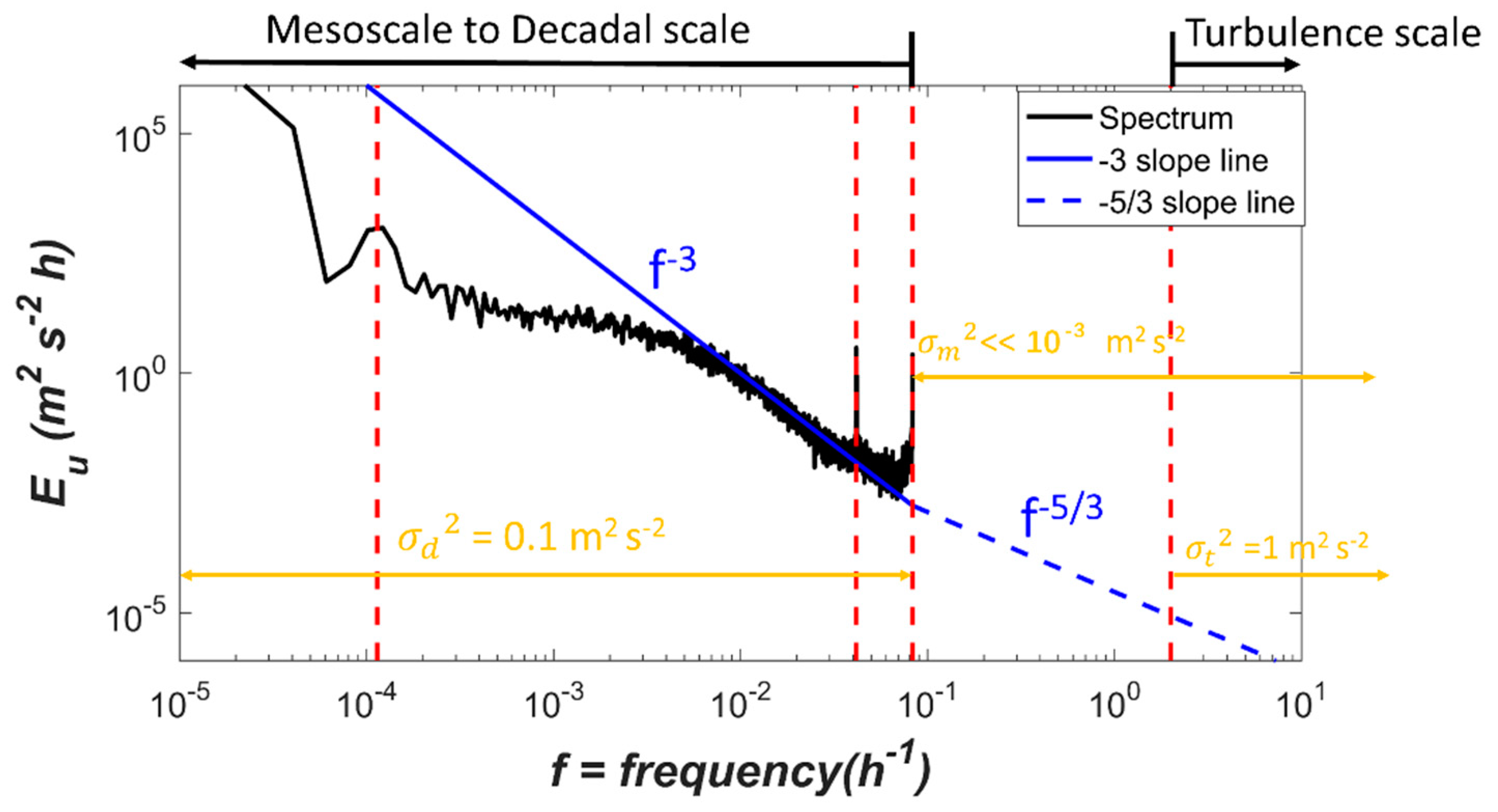
| Serial No. | Reference | Parameterization for CO2 |
|---|---|---|
| 1 | Wanninkhof (1992) [29] | 0.312 |
| 2 | Wanninkhof and McGillis (1999) [30] | 0.02833 |
| 3 | Nightingale et al. (2000) [34] | 0.2222 + 0.333 |
| 4 | McGillis et al. (2001) [35] | 0.0263 + 3.3 |
| 5 | McGillis et al. (2004) [36] | 0.0143 + 8.2 |
| 6 | Weiss et al. (2007) [37] | 0.3652 + 0.46 |
| 7 | Wanninkhof et al. (2009) [38] | 0.0113 + 0.0642 + 0.1 + 3 |
| 8 | Prytherch et al. (2010) [39] | 0.0343 + 5.3 |
| 9 | Ho et al (2006) [40], Sweeney et al. (2007) [41], Wanninkhof (2014) [33] | 2 (where = 0.266/0.27/0.251) |
| Method | Reference | Correction | Correction Details |
|---|---|---|---|
| 1 | This study | kb from Equation (11) (for quadratic relations) and Equation (13) (for cubic relations) are added to f() to estimate the corrected k. | Grid-by-grid spatially multi-year mean kb |
| 2 | This study | A simplified method using overall averaged value of kb to fix the bias. | |
| 3 | Wanninkhof (2002) [26] | (1) The corrected k with multiplier correction R2 (Equation (5)) for the quadratic parameterization is in the form of f, (2) For the cubic relation with multiplier correction R3 (Equation (6)), the corrected f() is expressed as | Assuming a Rayleigh distribution of the 6-hourly wind speeds, = and (See Text S1 in Supplementary for details). |
| 4 | Jiang et al. (2008) [28] | Global averaged multiplier correction factors R2 and R3 are estimated using the measured 6-hourly wind speed with R2 = 1.23 and R3 = 1.78. | |
| 5 | Fangohr et al. (2008) [27] | Zonal averaged R2 and R3 are used. Large gradients in zonal R2 and R3 are because of the large zonal gradients in wind variance (Figure S1). |
| Serial NO | Starting Value | Imposed Change | Imposed Change | ||||||||||||
|---|---|---|---|---|---|---|---|---|---|---|---|---|---|---|---|
| SST | SST | ||||||||||||||
| SST (°C) | 2% | 4% | 8% | 2% | 3% | 4% | 2% | 4% | 8% | 2% | 3% | 4% | |||
| Δk | k Sensitivity | ||||||||||||||
| 1 | 6.84 | 13.73 | 0.49 | 1.00 | 2.04 | 0.09 | 0.14 | 0.18 | 2.02 | 2.04 | 2.08 | 0.38 | 0.38 | 0.38 | |
| 2 | 0.47 | 0.95 | 1.98 | 0.06 | 0.09 | 0.11 | 3.06 | 3.12 | 3.25 | 0.38 | 0.38 | 0.38 | |||
| 3 | 0.39 | 0.79 | 1.61 | 0.08 | 0.12 | 0.16 | 1.84 | 1.85 | 1.89 | 0.38 | 0.38 | 0.38 | |||
| 4 | 0.43 | 0.88 | 1.82 | 0.07 | 0.11 | 0.15 | 2.19 | 2.24 | 2.32 | 0.38 | 0.38 | 0.38 | |||
| 5 | 0.23 | 0.47 | 0.98 | 0.08 | 0.12 | 0.16 | 1.08 | 1.10 | 1.15 | 0.38 | 0.38 | 0.38 | |||
| 6 | 0.42 | 0.86 | 1.75 | 0.08 | 0.12 | 0.16 | 2.02 | 2.04 | 2.08 | 0.38 | 0.38 | 0.38 | |||
| 7 | 0.43 | 0.87 | 1.77 | 0.08 | 0.12 | 0.16 | 2.02 | 2.04 | 2.08 | 0.38 | 0.38 | 0.38 | |||
| 8 | 0.30 | 0.60 | 1.24 | 0.06 | 0.10 | 0.13 | 1.72 | 1.74 | 1.80 | 0.38 | 0.38 | 0.38 | |||
| 9 | 0.40 | 0.81 | 1.65 | 0.07 | 0.11 | 0.15 | 2.02 | 2.04 | 2.08 | 0.38 | 0.38 | 0.38 | |||
Publisher’s Note: MDPI stays neutral with regard to jurisdictional claims in published maps and institutional affiliations. |
© 2021 by the authors. Licensee MDPI, Basel, Switzerland. This article is an open access article distributed under the terms and conditions of the Creative Commons Attribution (CC BY) license (https://creativecommons.org/licenses/by/4.0/).
Share and Cite
Gu, Y.; Katul, G.G.; Cassar, N. Mesoscale Temporal Wind Variability Biases Global Air–Sea Gas Transfer Velocity of CO2 and Other Slightly Soluble Gases. Remote Sens. 2021, 13, 1328. https://doi.org/10.3390/rs13071328
Gu Y, Katul GG, Cassar N. Mesoscale Temporal Wind Variability Biases Global Air–Sea Gas Transfer Velocity of CO2 and Other Slightly Soluble Gases. Remote Sensing. 2021; 13(7):1328. https://doi.org/10.3390/rs13071328
Chicago/Turabian StyleGu, Yuanyuan, Gabriel G. Katul, and Nicolas Cassar. 2021. "Mesoscale Temporal Wind Variability Biases Global Air–Sea Gas Transfer Velocity of CO2 and Other Slightly Soluble Gases" Remote Sensing 13, no. 7: 1328. https://doi.org/10.3390/rs13071328
APA StyleGu, Y., Katul, G. G., & Cassar, N. (2021). Mesoscale Temporal Wind Variability Biases Global Air–Sea Gas Transfer Velocity of CO2 and Other Slightly Soluble Gases. Remote Sensing, 13(7), 1328. https://doi.org/10.3390/rs13071328






